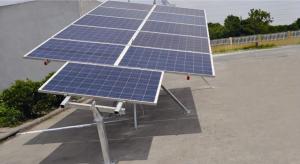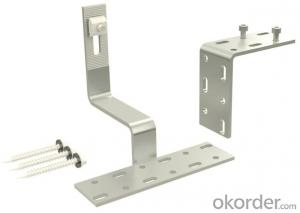Fixed Tilt Solar Racking System
- Loading Port:
- China Main Port
- Payment Terms:
- TT OR LC
- Min Order Qty:
- -
- Supply Capability:
- -
OKorder Service Pledge
OKorder Financial Service
You Might Also Like
Fixed Tilt Solar Racking System is applicable to install the usual framed module to tilt a certain angle with the roof. The solar system can be a fixed angle or adjustable such as 10~15 deg, 15~30 deg and 30~60 deg for your requirement. The special extruded aluminum rail, the tilt-in module, the clamp kit and the round leg can be high pre-assembly and make the installation easy and quick to save your labor cost and time. The customized length can eliminate the weld and cut onsite to keep the high anticorrosive performance, the structure strength and the appearance.
Features:
Install site :Low profile Roof or flat roof
Tilt Angle :10~60 deg
Building Height:20 m
Max Wind Speed:<60m/s
Snow Load:<1.4KN/m2
Standard :AS/NZS 1170 and other international Standard
Material :High Class Aluminum alloy Al6005-T5& Stainless steel 304
Anticorrosive: Anodized aluminum & stainless steel
Color: Natural and Customized
Warranty:Ten years warranty and twenty years service life
Benefits:
1. Easy to install. The tilt-in module can be put into the extruded rail from the any location and can be high pre-assembly with the clamp and leg to minimize the time and cost of installation
2. Offer unmatched durability: with all structural components comprised of high class stainless steel and anodized aluminum alloy, it is designed for twenty years service life and backed by ten years warranty.
3. Stand up to extreme weather. The grace solar roof tilt racking system is designed to stand up to the extreme weather complied with the AS/NZS 1170 and other international structure load standard by the skilled engineer. The main support components also have been test to guaranty its structure and load-carrying capacity.
4. Provide broad installation flexibility. These systems accommodate most commercially available framed solar panels and diverse roof types, and they can scale easily from small to large, multi-megawatt installations.

- Q: Can a solar mounting system be installed on a laboratory or research facility?
- Yes, a solar mounting system can be installed on a laboratory or research facility. Installing solar panels on such facilities can help reduce energy costs and promote sustainability. Additionally, solar power can be utilized to support the energy needs of the facility and contribute to a more environmentally-friendly operation.
- Q: Are there any specific requirements for clamps when using a solar mounting system on a standing seam metal roof?
- Yes, there are specific requirements for clamps when using a solar mounting system on a standing seam metal roof. The clamps must be designed specifically for standing seam roofs and should have features like non-penetrating design, adjustable sizing, and compatibility with the roof profile. It is crucial to choose clamps that provide a secure and watertight attachment without damaging the roof surface. Additionally, the clamps should meet the load and wind resistance requirements specified by the solar mounting system manufacturer.
- Q: Can a solar mounting system be installed on a data center or IT facility?
- Yes, a solar mounting system can be installed on a data center or IT facility.
- Q: Can a solar mounting system be used on sloped ground?
- Yes, a solar mounting system can be used on sloped ground. There are various types of solar mounting systems available, including those specifically designed for sloped terrain. These systems allow solar panels to be securely installed on sloped ground, maximizing sun exposure and energy production.
- Q: Can a solar mounting system be installed on a rooftop with a vented roof?
- Yes, a solar mounting system can be installed on a rooftop with a vented roof. The mounting system can be designed to accommodate the vents and ensure proper ventilation while also securing the solar panels in place.
- Q: Can a solar mounting system be installed on a gas station or convenience store?
- Yes, a solar mounting system can be installed on a gas station or convenience store. Solar panels can be mounted on the roof or on a ground-mounted system near the gas station or convenience store. This allows businesses to generate their own clean energy and reduce their carbon footprint, while also potentially saving on electricity costs.
- Q: Are there any specific requirements for installing solar mounting systems in snowy or icy regions?
- Yes, there are specific requirements for installing solar mounting systems in snowy or icy regions. These requirements typically include using specialized snow or ice guards to prevent snow accumulation on the solar panels, ensuring a steeper tilt angle to allow snow to slide off more easily, and using strong and durable mounting systems that can withstand heavy snow loads. Additionally, regular maintenance and clearing of snow or ice from the panels may be necessary to optimize energy production.
- Q: Can a solar mounting system be used on mountainsides?
- Yes, solar mounting systems can be used on mountainsides.
- Q: Are there any specific requirements for billboard or signage design when using a solar mounting system?
- Yes, there are specific requirements for billboard or signage design when using a solar mounting system. The design must take into account the weight and size of the solar panels, ensuring that the structure can safely support them. Additionally, the positioning and angle of the panels should be optimized for maximum sunlight exposure. It is also important to consider any local regulations or permits that may be required for the installation of solar-powered billboards or signs.
- Q: Can a solar mounting system be used in areas with historical preservation requirements?
- Yes, a solar mounting system can be used in areas with historical preservation requirements. However, it is important to ensure that the system is designed and installed in a way that meets the specific preservation guidelines and regulations of the area. This may involve working closely with preservation authorities and incorporating design elements that are sympathetic to the historical character of the surroundings.
Send your message to us
Fixed Tilt Solar Racking System
- Loading Port:
- China Main Port
- Payment Terms:
- TT OR LC
- Min Order Qty:
- -
- Supply Capability:
- -
OKorder Service Pledge
OKorder Financial Service
Similar products
Hot products
Hot Searches
Related keywords


























